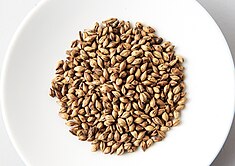Barley
| Barley | |
|---|---|
 |
|
| Drawing of Barley | |
| Scientific classification | |
| Kingdom: | Plantae |
| (unranked): | Angiosperms |
| (unranked): | Monocots |
| (unranked): | Commelinids |
| Order: | Poales |
| Family: | Poaceae |
| Subfamily: | Pooideae |
| Tribe: | Triticeae |
| Genus: | Hordeum |
| Species: | H. vulgare |
| Binomial name | |
|
Hordeum vulgare L. |
|
| Synonyms | |
|
List
|
|
 |
|
| Nutritional value per 100 g (3.5 oz) | |
|---|---|
| Energy | 1,473 kJ (352 kcal) |
|
77.7 g
|
|
| Sugars | 0.8 g |
| Dietary fiber | 15.6 g |
|
1.2 g
|
|
|
9.9 g
|
|
| Vitamins | |
| Vitamin A equiv. |
(0%)
13 μg160 μg
|
| Thiamine (B1) |
(17%)
0.191 mg |
| Riboflavin (B2) |
(10%)
0.114 mg |
| Niacin (B3) |
(31%)
4.604 mg |
| Pantothenic acid (B5) |
(6%)
0.282 mg |
| Vitamin B6 |
(20%)
0.26 mg |
| Folate (B9) |
(6%)
23 μg |
| Choline |
(8%)
37.8 mg |
| Vitamin C |
(0%)
0 mg |
| Vitamin K |
(2%)
2.2 μg |
| Minerals | |
| Calcium |
(3%)
29 mg |
| Iron |
(19%)
2.5 mg |
| Magnesium |
(22%)
79 mg |
| Manganese |
(63%)
1.322 mg |
| Phosphorus |
(32%)
221 mg |
| Potassium |
(6%)
280 mg |
| Sodium |
(1%)
9 mg |
| Zinc |
(22%)
2.13 mg |
|
|
|
|
|
| Percentages are roughly approximated using US recommendations for adults. | |
Barley (Hordeum vulgare L.), a member of the grass family, is a major cereal grain grown in temperate climates globally. It was one of the first cultivated grains, particularly in Eurasia as early as 13,000 years ago. Barley has been used as animal fodder, as a source of fermentable material for beer and certain distilled beverages, and as a component of various health foods. It is used in soups and stews, and in barley bread of various cultures. Barley grains are commonly made into malt in a traditional and ancient method of preparation.
In 2014, barley was ranked fourth among grains in quantity produced (144 million tonnes) behind corn, rice and wheat.
The Old English word for 'barley' was bære, which traces back to Proto-Indo-European and is cognate to the Latin word farina "flour". The direct ancestor of modern English "barley" in Old English was the derived adjective bærlic, meaning "of barley". The first citation of the form bærlic in the Oxford English Dictionary dates to around 966 CE, in the compound word bærlic-croft. The underived word bære survives in the north of Scotland as bere, and refers to a specific strain of six-row barley grown there. The word barn, which originally meant "barley-house", is also rooted in these words.
Barley is a member of the grass family. It is a self-pollinating, diploid species with 14 chromosomes. The wild ancestor of domesticated barley, Hordeum vulgare subsp. spontaneum, is abundant in grasslands and woodlands throughout the Fertile Crescent area of Western Asia and northeast Africa, and is abundant in disturbed habitats, roadsides and orchards. Outside this region, the wild barley is less common and is usually found in disturbed habitats. However, in a study of genome-wide diversity markers, Tibet was found to be an additional center of domestication of cultivated barley.
...
Wikipedia
